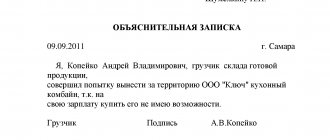The consultation is valid as of 09/14/2021.
The employee did not comply with the instructions of his immediate supervisor. The obligation to carry out the employer’s orders is specified in the employment contract, the duty to carry out the orders of managers is stated in the internal regulations, the employee is familiarized with these documents upon signature. No disciplinary measures were taken against the employee. The employee is deprived of the full bonus for failure to comply with the order of the immediate supervisor. When hired, the employee was not familiar with the bonus regulations in force in the organization at the time of hiring.
Are the employer’s actions legal in this situation? Was it possible to deprive an employee of a bonus, given that the employee was not familiar with the bonus regulations upon signature?
Terms and distinctions
Orders and instructions are similar to each other, being administrative documents of management in relation to personnel, tools through which the process of managing an organization takes place. Essentially, these are local regulations that document management decisions.
Current regulatory documents do not contain a clear definition of these concepts and their delimitation. They are, for example, in the “Concise Dictionary of Types and Varieties of Documents,” which was published in 1974. Many of the dictionary's formulations concerning the financial and organizational realities of the economy are now outdated, but taking them as a basis, one can obtain the following definitions.
An order is a sole local legal act issued by the head of the company or his deputy, who performs the relevant duties at the time the order is issued. It is intended to resolve core business or personnel issues. An order is also a legal act issued by the head of a government body or its structural unit in order to solve the problems facing the body. It may be relevant to a wide range of leaders, regardless of subordination, and have the force not of the LNA, but of a general normative act.
Order - issued by the head of the company, his deputies on operational issues, mainly of an organizational nature. They relate to the execution of orders, rules, instructions, and other regulations; mechanisms for communicating top management decisions to lower-ranking managers and ordinary employees. Often the order is limited in duration and concerns a limited number of persons.
On a note! An order is a specific form of administrative document, characteristic of military institutions. Published by the commander, the head of the institution.
Employer mistakes when imposing disciplinary sanctions
The employer may follow all the necessary procedures when imposing a penalty, but nevertheless, the court sides with the employee. Why?
Often, companies do not assign job responsibilities to employees properly. For example, certain responsibilities are agreed upon by the parties, but are not recorded either in the employment contract with the employee or in the job description. And it also happens that a job description exists, but the employee is not familiar with it by signature. In this case, it is impossible to punish an employee for performing job duties that are not properly established.
And when legal battles arise, the courts do not support the employer. Thus, when assessing the legality of imposing a disciplinary sanction in the form of a remark, the court proceeded from the fact that this paragraph of the order on disciplinary liability does not impose on the employee the obligation to personally prepare answers. And if so, then disciplinary liability cannot be imposed on the employee for improper organization of this work (Appeal ruling of the St. Petersburg City Court dated July 17, 2018 in case No. 2-941/2018).
On the other hand, it would seem that the employee’s guilt has been established. But the employer was negligent in completing the documents.
For example, a teacher was brought to disciplinary liability in the form of a reprimand for violating labor discipline after a student received a leg injury during a physical education lesson. At the same time, the employer did not clarify the circumstances of the disciplinary offenses, did not establish the teacher’s guilt in committing them, or the cause-and-effect relationship between her actions and the resulting consequences. The employer's orders do not indicate what specific actions of the teacher the employer considered a violation of official duties (Determination of the Judicial Collegium for Civil Cases of the Armed Forces of the Russian Federation dated August 5, 2019 No. 5-КГ19-97).
Important!
In the order to bring disciplinary liability to the employer, it is necessary to indicate the offense that became the reason for punishment (clause 10 “Review of the practice of courts considering cases on disputes related to the termination of an employment contract at the initiative of the employer”, approved by the Presidium of the Armed Forces of the Russian Federation on December 9, 2020) .
When imposing disciplinary sanctions, the employer must take into account the severity of the offenses committed and the employee’s previous attitude towards work.
The employer must follow a specific procedure for imposing disciplinary action. For example, before applying disciplinary sanctions to the employee in the form of a reprimand and dismissal, the employer did not require written explanations from her for each offense. In addition, the employer did not establish the circumstances of the disciplinary offenses; it did not indicate which actions of the employee the employer considered a violation of official duties, as well as at what time such actions were committed by her (Determination of the Judicial Collegium for Civil Cases of the Armed Forces of the Russian Federation dated May 13, 2019 No. 48-KG19 -3).
How to apply documents
It follows from the definitions that the order, in contrast to the order, is primarily advisory in nature. It indicates the most optimal way to solve a management problem and requires agreement. An order requires unconditional obedience and precision execution. At the same time, in many situations, the order is close in content to an order.
Let us pay attention to some characteristic features of the two documents:
- The order is valid until canceled, the instruction - until actual execution.
- Orders, as a rule, are reissued if necessary; changes can be made to the order using the same administrative document - an order. The text of the amending order includes the text of the relevant changes.
- When issuing an order, the title “Order” is always indicated in the document; in orders, the title is often omitted. When drawing up an order, the text begins with the words “I oblige, I oblige, I dispose,” and in the order – “I order.”
An example of an order is an order for hiring, and an order can formalize a short-term assignment of duties to a member of the workforce during the vacation of the main employee. In practice, these two documents are often perceived identically and have equal validity in organizations.
Many companies, especially small ones, use one type of administrative document. Usually, priority is given to the order, but only orders can be issued. In other cases, for example, in the presence of structural divisions, orders are issued by the heads of these structural divisions, and orders are issued by the head and the persons performing his duties.
From a legal point of view, there is no difference between an order and an order; the organization is obliged to regulate these issues independently. The delineation of the validity of documents is made with the help of regulations, other LNA, which prescribe situations in which it is necessary to prepare a draft order or regulation.
There are certain cases defined by law. The Charter of a joint stock company usually states that the director issues orders (according to Article 69-2 of the Federal Law No. 208 of 12/26/95), which means that deputies may be given the authority to issue orders.
1.2. Features of illegality of an order or instruction
According to the opinion, an illegal order is one that does not comply with the Criminal Code of the Russian Federation, i.e., contains a requirement to commit a crime. Illegality in criminal law means criminality.
This interpretation is incorrect. If the legislator were to use illegality in such a context, he would use the term “criminal.” Nevertheless, the Criminal Code of the Russian Federation uses a broader concept - “illegal”. A “criminal” order contains instructions to commit a crime. An illegal order only implies a failure to comply with some condition of legality. From the literal interpretation of Art. 42 of the Criminal Code of the Russian Federation it follows that it deals with illegality, and not with crime.
The law in this context is interpreted broadly - as laws and regulations, regulations of private and public organizations. "Law" in Art. 42 of the Criminal Code of the Russian Federation means a normative act[2].
If a person gives an illegal order, foresees the commission of an act provided for by the Criminal Code of the Russian Federation, and desires or consciously allows (or is indifferent to) this, such illegality entails crime and the order, accordingly, is called criminal. Its implementation may lead to socially dangerous consequences, both directly and indirectly. In other words, when giving this order, the subject is aware of its illegality in the context of the criminal law.
If there is a careless act, the situation is similar if there is frivolity. The exception is negligence: the boss, violating the norm of any law (regulatory act), does not foresee the possibility of causing harm, although he should and could have foreseen it, and does not realize the social danger of the act itself. The executor of such an order may or may not detect its potential harmfulness. In the future, he will either act in accordance with the norms of Part 2 of Art. 42 of the Criminal Code of the Russian Federation, or not. Thus, in practice, a polar situation is quite possible, when the boss acts out of negligence, and the performer acts with direct intent.
……..
The procedure for issuing orders and instructions
Orders and instructions have basically a similar procedure for formation, publication and control of execution:
- initiating actions based on the reason for issuing the document;
- collection of information, its analysis;
- formation of a draft order, instruction based on the work performed;
- registration of comments and proposals of interested parties, approval;
- signing a document;
- document registration;
- bringing to the attention of performers.
The initiative can come from the head of the company or from the heads of departments (memos, memos, official letters to the manager). The publication of a document may be of a planned nature and be based on the norms of previously adopted LNA, for example, an order to conduct an inventory.
Coordination and revision, if necessary, is carried out taking into account the opinions of employees, the trade union, lower-level managers, and in some cases, external organizations involved in solving the problem discussed in the document (superior management of the organization, experts). In other cases, the order or instruction does not require a finalization stage.
The work is carried out in accordance with GOST R 7.0.97-2016, the requirements for document preparation of which apply to instructions and orders.
Commentary on Article 42 of the Criminal Code of the Russian Federation
1. Military and service discipline require subordinates to fulfill obligatory acts of management, including those emanating from a superior or manager. Therefore, the law establishes as a general rule (Part 1 of the commented article) that causing harm to legally protected interests as a consequence of a person’s execution of an order or instruction that is obligatory for him cannot entail criminal liability for this act. The person who gave an illegal order or instruction is subject to liability. In this case, there is mediocre harm (see Part 2 of Article 33 of the Criminal Code).
2. An order is an authoritative demand based on normative legal acts, issued in the order of subordination by an authorized person, clothed in the proper form, addressed to the person (person) subordinate (subordinate) to him in the service, obligated (obliged) to fulfill it. An order differs from an order: it is issued not only by the manager (chief), but also by any other subject of management (for example, a deputy manager); addressed not only to subordinates, but also to other persons included in the sphere of relations where this act is in force; contains the nature of the requirements not for service, but for other general issues. In relation to orders and instructions, there is a presumption of their legality, and therefore they must be carried out unquestioningly, accurately and on time.
3. Execution of an order or instruction excludes the criminality of the act if: they were mandatory for execution by a specific person; were illegal; the person who performed it did not realize their illegality.
An order and instruction are binding if they are given by an appropriate person to a subordinate, within the powers of that person, are properly executed, and are not obviously illegal.
In accordance with the norms of acts of a military legal nature, under the conditions of the principle of unity of command, a military personnel cannot be given orders and instructions, or assigned tasks that are not related to service or aimed at violating the law.
Failure by a subordinate to comply with an order from a superior given in the manner prescribed by law is considered a crime against military service (see commentary to Article 332). If, after the verdict enters into force, the order for failure to comply with which the serviceman was convicted is declared illegal, the proceedings in the case are resumed due to a new circumstance <1>.
——————————— <1> Determination of the Military Collegium of the RF Armed Forces dated May 21, 2009 N 4n-90/09.
Execution by a subordinate of an order or instruction, the illegality of which was not obvious to him, cannot entail criminal liability for this person for the act and harm caused to legally protected interests in execution of such an order or instruction.
4. Criminal liability for any of the intentional acts provided for by the Criminal Code accrues to a subordinate if this act (action or inaction) was committed by him in pursuance of a knowingly illegal order or instruction of his superior (manager), i.e. when he realizes the obvious illegality of this order (instruction), primarily in its content.
A boss (manager) who has given a knowingly illegal order or instruction, which led to the commission of a deliberate crime by a subordinate in execution of this order (instruction), is the organizer of this crime (Part 3 of Article 33 of the Criminal Code), and the person who carried out such a knowingly illegal order ( order), - its executor (Part 2 of Article 33 of the Criminal Code). If a boss, together with a subordinate, acting on his obviously illegal order (instruction), jointly carried out the objective side of the corresponding intentional crime, then they are responsible for the crime committed by a group of persons by prior conspiracy (Part 2 of Article 35 of the Criminal Code).
The fact that the subordinate carried out, although obviously illegal, but still the order or instruction of his superior (manager), can be considered as a mitigating circumstance (clauses “e” and “g” part 1 of article 61 of the Criminal Code) .
5. In some cases, physical or mental coercion on the part of a person who has given a knowingly illegal order (instruction) can create a state of extreme necessity for a subordinate, and therefore, the issue of liability for causing harm to them in execution of such an order (instruction) should be resolved according to the rules Art. 39 of the Criminal Code.
6. A person who refuses to carry out a knowingly illegal order or instruction cannot be held accountable for this (Part 2 of the commented article).






